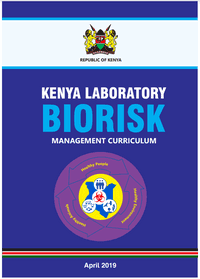Kenya Laboratory Biorisk Management Curriculum
[KLBRMC]
This curriculum consists of eleven modules that emphasize bio-threat reduction and integrate biosafety and biosecurity management. It is geared toward training personnel such as hands-on laboratory technicians, managers and supervisors, top management, field biological workers, and support staff working in human, animal, and plant sectors as well as other relevant sectors. The curriculum intends to reduce dual use risks, mitigate biological proliferation and deliberate use threats, and ensure safe custody of biological agents.
SUMMARY
This document is the second edition of the Kenya Laboratory Biorisk Management Curriculum (KLBRMC) and was published in April 2019. It contains curriculum improvements geared toward Biorisk Management (BRM) on the basis of a one-health approach through eleven modules. These modules focus on bio-threat reduction particularly in the face of continued disease outbreaks, emerging and re-emerging disease pathogens, and bioterrorism threats. The curriculum integrates international best practices that strengthen BRM systems for the human, animal and plant health sectors as well as other sectors. Focusing on workforce development of bioscience practitioners, its objectives include enabling workers with skills in biosafety and biosecurity to enhance safety when working with biological agents. Published jointly by the Kenyan Ministry of Health and Ministry of Agriculture, Livestock, Fisheries and Irrigation, the curriculum is a derivative of the World Health Organization (WHO) Joint External Evaluation (JEE) exercise for Kenya through the Global Health Safety Agenda initiative. The curriculum received financial and technical support from strategic development partners on BRM**.** It targets the need to train management and leadership, technical field workers, and support staff in biorisk management and also other cadres in different sectors that are regularly involved in these activities. This resource aims to protect personnel from potentially harmful pathogens as well as secure infectious agents against accidental release or deliberate misuse to harm people, animals, plants, or the environment. The curriculum will consist of face-to-face teaching, e-learning, practical demonstrations, and group or individual work assignments. This curriculum is openly accessible from the Kenyan Ministry of Health website and it is published in English.


..png)
